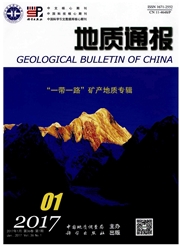

 中文摘要:
中文摘要:
系统分析青藏高原新生代中新世50余个沉积盆地的类型、构造背景、岩石地层序列,对青藏高原中新世构造岩相古地理演化特征进行分析和探讨。中新世,青藏高原海相沉积已经全面退出,全部转为陆相沉积,约23Ma时高原及周边不整合面广布,标志高原整体隆升。塔里木、柴达木及西宁一兰州、羌塘、可可西里等地区主体表现为大面积的构造压陷湖盆沉积。约17.2Ma左右。阿尔金山显著隆升,使柴达木盆地西叉沟一带再无生物礁灰岩出现,且在盆地西部出现了短暂的沉积间断。这一时期,柴达木盆地西部开始进入湖退期,而东南部则快速湖进;同时,大约17.7Ma索尔库里山间盆地初始凹陷形成。另外,高原腹地五道梁一沱沱河盆地受南部唐古拉山的挤压抬升,在16Ma左右结束了五道梁组的沉积.在可可西里一唢呐湖一带则再次凹陷接受唢呐湖组沉积,形成高原腹地的大型压陷湖盆。13~10Ma期间,藏南南北向断陷盆地的形成,是高原隆升到足够高度开始垮塌的标志;约8Ma以来,高原东北部几乎所有湖盆均进入湖退期,普遍出现;中积扇、辫状河和水下扇砂砾岩堆积。
 英文摘要:
英文摘要:
Based on a systematic analysis of the types of 50 Miocene sedimentary basins as well as their tectonic settings and lithostrati- graphic sequences in the Tibetan Plateau, the authors investigated the evolution of the Miocene tectonic hthofacies paleogeography in the Tibetan Plateau. During the Miocene, marine sedimentation of the Tibetan Plateau was quitted completely, and changed into ter- restrial deposition completely. At ca. 23Ma, the unconfomfities between the plateau and the surrounding areas were widespread, that marked the overall uplift of the plateau. The main bodies of Tarim, Qaidam, Xining-Lanzhou, Qiangtang, and Hoh Xil areas were characterized by large-area tectonic compressive lacustrine basin deposits. At ca. 17.2Ma. the Altun Mountains were uplifted evidentlyand, as a result, there was no more reef limestone in Xichagou area of Qaidalrl Basin. In the west of th,~ basin, there existed short de- position disconnection. From this time, the west part of Qaidam Basin began to show lacustrine regression, but the southeast of the basin began to show lacustrine transgression quickly. At ca 17.7Ma or so, the initial sag of the Suoerkuli intemlontane basin was formed. Moreover, Wudaoliang-Tuotuohe basra of the plateau hinterland was uplifted due to the compression of southern Tanggula Kange. At ca. 16Mr, the deposition of the Wudaoliang Formation was finished, and Hoh Xil--Suolahu sag was forined again together with the generation of Suolahu Formation, producing large compressional lacustrine basins in the plateau hinterland. At about 13- 10Mr, the formation of NS-trending faulted basins in south Tibet, such as the formation of Jilong basin, Musitang basin and Pulan basin, was the mark that the plateau was uplifted to its peak and began to collapse. Since about 8 Ma, in the northeast of the plateau, almost all lacustrine basins entered into the stage of regression, and there was sandy conglomerate accumularion of alluvial fan, braided river and subaqueous fan.
 同期刊论文项目
同期刊论文项目
 同项目期刊论文
同项目期刊论文
 Pre-Rodinia supercontinent Nuna shaping up: A global synthesis with new paleomagnetic results from N
Pre-Rodinia supercontinent Nuna shaping up: A global synthesis with new paleomagnetic results from N Extended stratigraphy, palynology and depositional environments record the initiation of the Himalay
Extended stratigraphy, palynology and depositional environments record the initiation of the Himalay Systematics and palaeoecology of Changhsingian (Late Permian) Ambocoeliidae brachiopods from South C
Systematics and palaeoecology of Changhsingian (Late Permian) Ambocoeliidae brachiopods from South C Climatic and tectonic uplift evolution since similar to 7 Ma in Gyirong basin, southwestern Tibet pl
Climatic and tectonic uplift evolution since similar to 7 Ma in Gyirong basin, southwestern Tibet pl Organic carbon isotope constraints on the dissolved organic carbon (DOC) reservoir at the Cryogenian
Organic carbon isotope constraints on the dissolved organic carbon (DOC) reservoir at the Cryogenian How severe is the modern biotic crisis? - A comparison of global change and biotic crisis between Pe
How severe is the modern biotic crisis? - A comparison of global change and biotic crisis between Pe Environmental determinants and ecologic selectivity of benthic faunas from nearshore to bathyal zone
Environmental determinants and ecologic selectivity of benthic faunas from nearshore to bathyal zone Diagenetic control of magnetic susceptibility variation in Core MD98-2172 from the Eastern Timor Sea
Diagenetic control of magnetic susceptibility variation in Core MD98-2172 from the Eastern Timor Sea Sedimentary geochemistry and provenance of the Lower and Middle Devonian Laojunshan Formation, the N
Sedimentary geochemistry and provenance of the Lower and Middle Devonian Laojunshan Formation, the N Paleogene-Neogene stratigraphic realm and sedimentary sequence of the Qinghai-Tibet Plateau and thei
Paleogene-Neogene stratigraphic realm and sedimentary sequence of the Qinghai-Tibet Plateau and thei Zoophycos composite ichnofabrics and tiers from the Permian neritic facies in South China and south-
Zoophycos composite ichnofabrics and tiers from the Permian neritic facies in South China and south- Palaeoecology and taphonomy of two brachiopod shell beds from the Anisian (Middle Triassic) of Guizh
Palaeoecology and taphonomy of two brachiopod shell beds from the Anisian (Middle Triassic) of Guizh Isotopic evidence for an anomalously low oceanic sulfate concentration following end-Permian mass ex
Isotopic evidence for an anomalously low oceanic sulfate concentration following end-Permian mass ex Provenance record of a foreland basin: Detrital zircon U-Pb ages from Devonian strata in the North Q
Provenance record of a foreland basin: Detrital zircon U-Pb ages from Devonian strata in the North Q Revised conodont zonation and conodont evolution across the Permian-Triassic boundary at the Shangsi
Revised conodont zonation and conodont evolution across the Permian-Triassic boundary at the Shangsi Microbial lipid records of highly alkaline deposits and enhanced aridity associated with significant
Microbial lipid records of highly alkaline deposits and enhanced aridity associated with significant The origin of decoupled carbonate and organic carbon isotope signatures in the early Cambrian (ca. 5
The origin of decoupled carbonate and organic carbon isotope signatures in the early Cambrian (ca. 5 Microbial response to limited nutrients in shallow water immediately after the end-Permian mass exti
Microbial response to limited nutrients in shallow water immediately after the end-Permian mass exti Morphological association of microbially induced sedimentary structures (MISS) as a paleoenvironment
Morphological association of microbially induced sedimentary structures (MISS) as a paleoenvironment Geochemical evidence from bio-apatite for multiple oceanic anoxic events during Permian-Triassic tra
Geochemical evidence from bio-apatite for multiple oceanic anoxic events during Permian-Triassic tra 期刊信息
期刊信息
